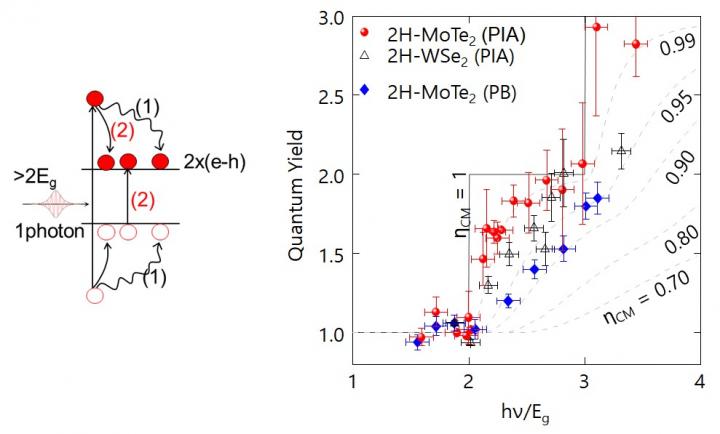2D semis boost carrier multiplication

Korean team discover a carrier multiplication process in 2D semiconductors that could increase the efficiency of future solar cells
Physicists at the Centre for Integrated Nanostructure Physics (CINAP), within the Institute for Basic Science (IBS, South Korea), have discovered an intriguing phenomenon, known as carrier multiplication (CM), in 2D semiconductors.
Published in Nature Communications, these new findings have the potential to boost the photovoltaics and photodetector fields, and could improve the efficiency of solar cells produced with these ultrathin materials to up to 46 percent, say the researchers.
The van der Waals layered transition metal dichalcogenides (2D-TMDs), are expected to create the next-generation of optoelectronic devices, such as solar cells, transistors, and LED. They have unique optical properties, high light absorption, and high carrier (electron and hole) mobility.
Beyond allowing the option to tune their band gap by changing composition and layer thickness, these materials also offer an ultrahigh internal radiative efficiency of >99 percent, promoted by the elimination of surface imperfections and large binding energy between carriers.
Absorption of sunlight in semiconducting 2D-TMD monolayers reaches typically 5-10 percent, which is an order of magnitude larger than that in most common photovoltaic materials, like silicon, CdTe, and GaAs.
Despite these ideal characteristics, the maximum power conversion efficiency of 2D-TMDs solar cells has remained below 5 percent due to losses at the metal electrodes. The IBS team in collaboration with researchers at the University of Amsterdam aimed to overcome this drawback by exploring the CM process in these materials.
CM is a very efficient way to convert light into electricity. A single photon usually excites a single electron, leaving behind an 'empty space' (hole). However, it is possible to generate two or more electron-hole pairs in particular semiconductors if the energy of the incident light is sufficiently large, more specifically, if the photon energy is twice the material's bandgap energy.
While the CM phenomenon is rather inefficient in bulk semiconductors, it was expected to be very efficient in 2D materials, but was not proved experimentally due to some technical limitations, like proper 2D-TMD synthesis and ultrafast optical measurement.
In this study, the team observed CM in 2D-TMDs, namely 2H-MoTe2 and 2H-WSe2 films, for the first time; a finding that is expected to improve the current efficiency of 2D-TMD solar cells, even going beyond the Shockley-Queisser limit of 33.7 percent.The schematic above demonstrates the photogenerated carriers with carrier multiplication (CM)
"Our new results contribute to the fundamental understanding of the CM phenomenon in 2D-TMD. If one overcomes the contact losses and succeeds in developing photovoltaics with CM, their maximum power conversion efficiency could be increased up to 46 percent," says Young Hee Lee, CINAP director. "This new nanomaterial engineering offers the possibility for a new generation of efficient, durable, and flexible solar cells."


































